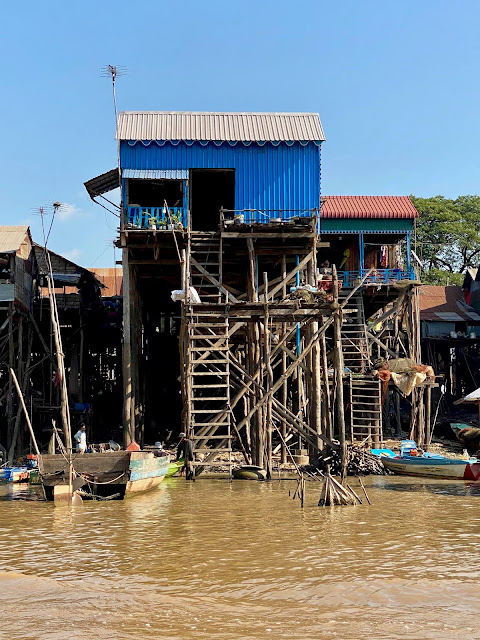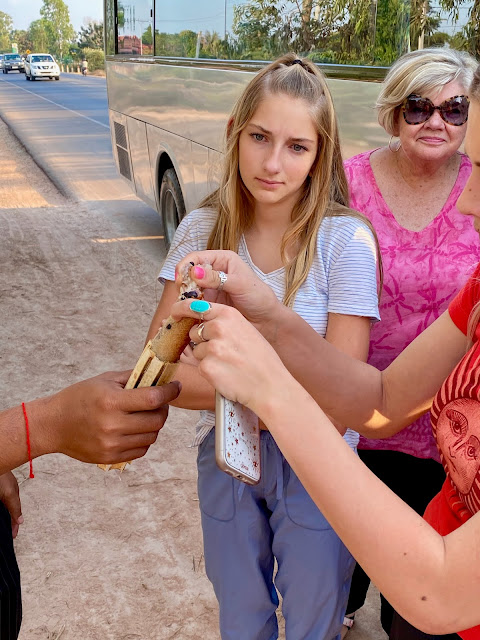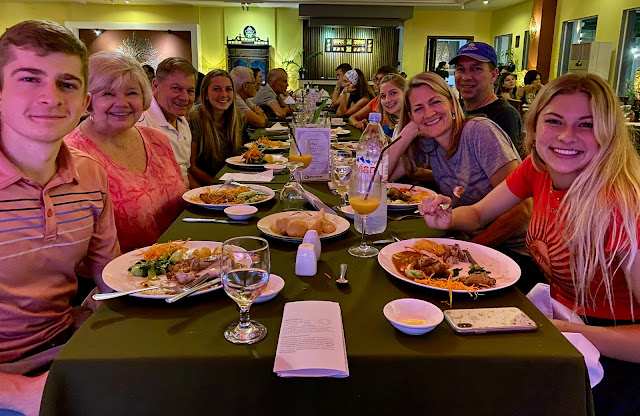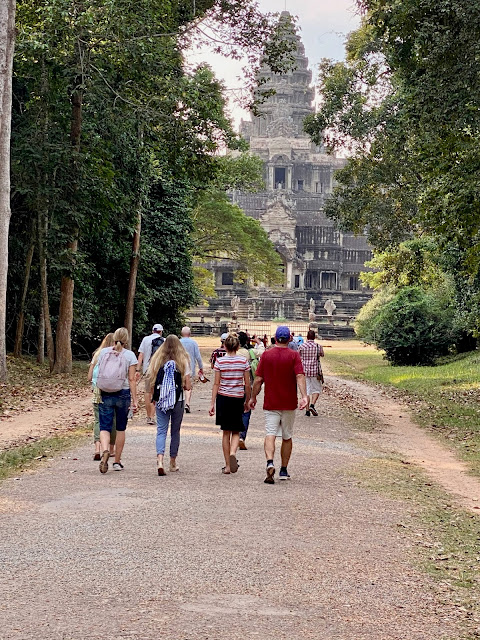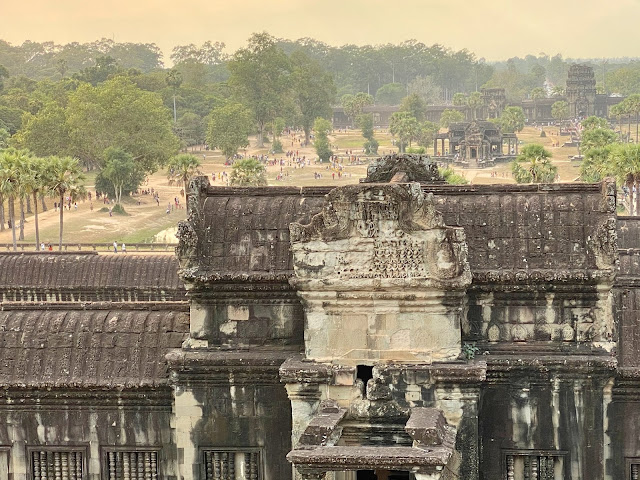Our guide, Saudi, picked us up at the Siem Reap airport and we drove to a pretty spot
for our outdoor lunch,
for our outdoor lunch,
which was on the way to the floating village called Kompong Khleang.
The floating village we were headed to visit is located along a tributary river
emptying into Tonil Sap Lake,
which is the largest fresh water lake in Southeast Asia.
It is one of the richest fishing grounds in the world.
Roger and I shared this steamed fish lunch.
Lunch time siesta
After lunch, we drove to a dock to board a boat that took us on the river by many houses on stilts.
They are on stilts because the Tonil Sap Lake, which it leads to, is like a big bowl
that fills with water when the Tonil River flows into it.
It empties when the Tonil River changes direction, as it does every year, and flows out of it.
This river is part of the Mekong River system, which swells with monsoons and snow melt
from the Himalayas in the wet season.
Over 80,000 people live along the rivers and on the lake. There are 170 floating villages.
Most are fishermen and the annual income is under $500.
Because of the difficult life they lead, life expectancy is 54 years old.
As we progressed further toward the lake, the houses disappear
and are replaced by mangrove forest and open water.
Some fishing families become farmers, growing snake beans and watermelons.
The open water of Tonil Sap Lake.
On the return boat ride, this cute little guy who had been sitting up front with our driver,
started giving Jodie a back massage.
After about ten minutes, he proceeded to give a massage to each of us girls.
He had had training and it felt wonderful!
We paid him one American dollar each and he was tickled!
He was shy, but Roger got him to smile. Isn't he adorable?
The harbor on the return trip
On our bus ride back to our hotel, our guide, Dariem, had the driver stop by the side of the road
so we could sample Kranlan.
It is sticky rice and black beans cooked in coconut milk and stuffed in bamboo, then roasted over charcoal.
There were many stands cooking these along the road.
It had a sweet, crusty exterior, and I have to say, it tasted absolutely delicious!
We drove back to Siem Reap and checked into our hotel, Angkor Miracle Resort.
It was furnished with beautiful hardwood floors.
That evening we were taken to an Apsara dinner show
and enjoyed watching traditional Cambodian dance.
The next day started with a 3:30 am wake-up!
Just over three miles from our hotel are the famous temple ruins of Angkor.
Covering an area of over 400 acres, it is one of the most significant archeological sites in Southeast Asia.
The region contains the remains of the different capitals of the Khmer Empire,
dating from the 9th through the 15th centuries.
Angkor Wat (wat means temple) was built as a Hindu place of worship,
but in 1432, when the capital moved to Phnom Penh, Angkor Wat was maintained by Buddhist monks.
Rediscovered in modern times after being covered over with jungle growth,
Angkor Wat is said to be the largest religious monument in the world.
And it is probably the greatest tourist attraction in Cambodia.
So, a highly-desirable thing to do is see the Angkor Wat at sunrise.
There was a cloud cover forecast,
but that did not deter hoards of tourists from showing up at sunrise.
It really was quite a remarkable sight!
And, though I hate to admit it, was worth the early wake-up!
Angkor Wat is surrounded by water.
We walked over a squishy covering over water to get to the ruins.
We walked over a squishy covering over water to get to the ruins.
Each tower features graduated tiers that create a cone shape, and the highest tower within the temple complex is 699 feet.
I am so glad I got to walk around these famous ruins!
The bas-reliefs were designed to be viewed from left to right in the order of a Hindu funeral ritual.
Before we returned to our hotel for breakfast, we were taken on a boat ride on the Siem Reap River
at the south gate of Angkor Tom, where everyone else returned to visit.
I stayed in the boat, but everyone else climbed up some steep stairs to view old Buddhist temple ruins.
On the return ride, we saw these Cambodian picnicers.
We were returned to our hotel for a breakfast buffet at about 10 am, then all of the others departed
to hike around the many sites of the ruins the rest of the day.
The temperature was in the high 90s, so was the humidity and there would be much hiking and climbing.
I thought I would take a nap after the early wake-up and I rested on my bed in the cool air-conditioning,
but, after I cleaned up, I decided to explore around our hotel.
There was a cute boutique just off the entrance, and that was really the most time I had to shop the entire trip.
I found a couple of pretty caftans that were imported from Dubai, then I returned to my room
and ordered room service. I had the yummiest mango sticky rice ever!
They all took some great pics of the various sites they explored.
I didn't hear the stories about them, but here are some highlights, narrated by Roger:
The central tower of the Thom stone gate is capped by three face-towers. Below them at the base of the gate are two sets of elephants statues that flank the entrance on both sides. Sitting on each elephant is a figure of the god Indra carrying his usual weapon the vadra (a lighting bold).
We stopped to take a picture at the famous Thom South Gate at Ankor from the late 12th century.
It is approached via a causeway that extends about one third mile, fashioned by 54 stone figures engaged in the performance of a famous Hindu story.
On the left side are the guardian gods and the right side are the demon gods.
The etchings on the interior wall that surrounds the temple depict every day scenes of how the people lived.
I was impressed by all the stone arches holding up the structure throughout the temples.
Nose to nose!
Send them to Hollywood!
Phimeanakas is the celestial temple at Angkor.
We were amazed at the trees growing over and through the ruins at the Ta Prohm temple.
The larger trees are silk-cotton trees called thitpok,
and the smaller trees are
a strangler fig or gold apple, called badhis.
As Josh and Katie explored, they could even get inside the roots of the trees.
The girls taking a break with our guide Saudi
We returned to Angkor Wat Temple and explored it further. There is so much to see!
Up on top of the east gate, looking back at the crowds of people entering Angkor Wat.
They literally walked, hiked and climbed from sunrise to sunset.
They returned to our hotel about 7 pm.
The sunset was beautiful!
While I was waiting for them to return, it was interesting to watch from my balcony the hotel personnel
set up for their big New Year's Eve Gala.
There was some intense labor going on, bringing out trays and trays of food and carrying ice sculptures
on their backs from the kitchen at the opposite end of the hotel from where the outdoor party was held.
Lobby of our hotel
We went to the party early to eat our dinner.
There were many hotel guests from all over the world, as well as many locals who came to the party.
As we entered we were each given a Krama scarf.
They had tables and tables of all kinds of food imaginable and the entertainment on a set-up stage
blared through the evening until midnight, with fireworks following.
All of us went to bed early with ear plugs!
It was a big, exhausting day for the hikers!
Everyone was provided with noise makers at the tables and I had to give a quick toot!
HAPPY NEW YEAR!
Our last destination came all too soon!
We flew to Bangkok next morning!








